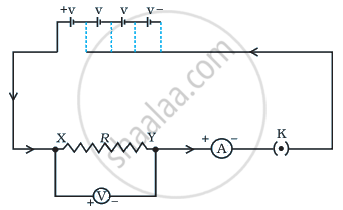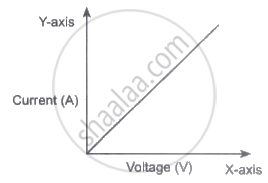Advertisements
Advertisements
Question
You are provided with a resistor, a key, an ammeter, a voltmeter, four cells of 1.5 V each and few connecting wires. Using circuit components, draw a labelled circuit diagram to show the setup to study Ohm's law.
State the relationship between potential difference (V) across the resistor and the current (I) flowing through it. Also draw V-I graph, taking V on the X-axis.
Solution

According to Ohm's law, the potential difference (V) across the ends of a resistor is directly proportional to the current (I) flowing through it provided its temperature remains the same.
i.e., V ∝ I
or V/I = constant = R
or V = RI
Here R is a constant for the given resistor at a given temperature and is called its resistance.
The SI unit of resistance is ohm (Ω).
A straight line that travels through the origin represents a graph between the potential difference between a resistor's two ends and the current that flows through it. This graph's slope provides the resistor's resistance R.
We test the potential difference across two resistor ends at various currents flowing through it in an electric circuit to confirm Ohm's law. An ammeter is connected in series with the resistor to measure the current flowing through it. By placing a voltmeter in parallel with the resistor, the potential difference between its two ends may be determined.
A straight-line graph obtained between V and I verify the ohm's law.

